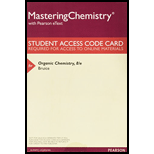
(a)
Interpretation: The given target molecules synthesized using reterosynthetic analysis has to be discussed.
Concept introduction: Reterosynthesis analysis are a series of logical backward steps in the synthesis of the target molecule. It is basically a backward reaction. The starting material is formed in the final step. Thus, the reverse of any reaction to form the starting material can be termed as reterosynthesis.
(b)
Interpretation: The given target molecules synthesized using reterosynthetic analysis has to be discussed.
Concept introduction: Reterosynthesis analysis are a series of logical backward steps in the synthesis of the target molecule. It is basically a backward reaction. The starting material is formed in the final step. Thus, the reverse of any reaction to form the starting material can be termed as reterosynthesis.
(c)
Interpretation: The given target molecules synthesized using reterosynthetic analysis has to be discussed.
Concept introduction: Reterosynthesis analysis are a series of logical backward steps in the synthesis of the target molecule. It is basically a backward reaction. The starting material is formed in the final step. Thus, the reverse of any reaction to form the starting material can be termed as reterosynthesis.
(d)
Interpretation: The given target molecules synthesized using reterosynthetic analysis has to be discussed.
Concept introduction: Reterosynthesis analysis are a series of logical backward steps in the synthesis of the target molecule. It is basically a backward reaction. The starting material is formed in the final step. Thus, the reverse of any reaction to form the starting material can be termed as reterosynthesis.
Want to see the full answer?
Check out a sample textbook solution
Chapter 17 Solutions
Organic Chemistry - MasteringChemistry
- Chemistry show how to carry the following synthesis.arrow_forwardUsing acetylene as your only source of carbon atoms, design a synthesis of pentanal, a 5 carbon aldehyde, CH3CH2CH2CH2CHOarrow_forwardThis synthesis makes use of two blocking groups, the benzyl (Bn) group and the tetrahydropyranyl (THP) group. Draw a structural formula of each group and describe the experimental conditions under which it is attached and removed.arrow_forward
- Which of the following reactions will not produce a carboxylic acid? Benzaldehyde + hot, conc'd KMnO4 1) Ph-N2+ + KI 2) BrMgCH=CH2 in ether, followed by H3O+ sec-butylBenzene + hot, conc'd KMnO4 1) Benzene, HNO3 + H2SO4; 2) Fe, HCl; 3) NaNO2; 4) CuCN; 5) dilute acid and heat 1) Benzene and acetyl chloride & AlCl3; 2) HCl & Ni Thank you!arrow_forwardI have proposed a suitable synthesis for the following transformation please let me know whether or not this is correct. If incorrect please let me know what I did wrong.arrow_forwardShow how you could synthesize para-broom benzoic acid starting with benzene.arrow_forward
- Show the retrosynthetic analysis of 1-Pentanoic acid and then further show the synthesis of the same ?arrow_forwardShow the interconversion of the functional group and where the compound disconnects (show where the disconnection occurs). And show the donor synthone and acceptor synthone and the appropriate reagents for the compoundarrow_forwardGiven this retrosynthetic analysis, show how meclizine can be synthesized from the four named organic starting materials.arrow_forward
 Organic Chemistry: A Guided InquiryChemistryISBN:9780618974122Author:Andrei StraumanisPublisher:Cengage Learning
Organic Chemistry: A Guided InquiryChemistryISBN:9780618974122Author:Andrei StraumanisPublisher:Cengage Learning Organic ChemistryChemistryISBN:9781305580350Author:William H. Brown, Brent L. Iverson, Eric Anslyn, Christopher S. FootePublisher:Cengage Learning
Organic ChemistryChemistryISBN:9781305580350Author:William H. Brown, Brent L. Iverson, Eric Anslyn, Christopher S. FootePublisher:Cengage Learning

